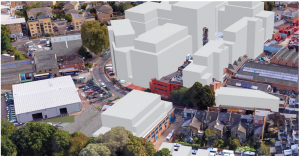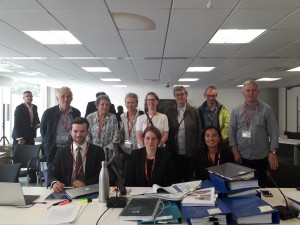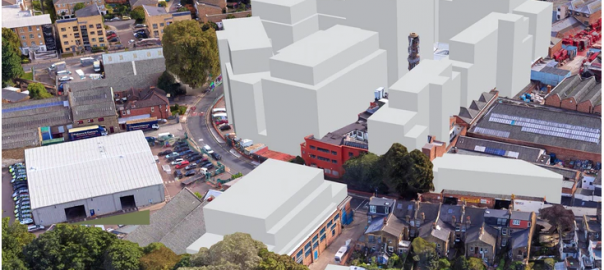Burgess Business Park planning inquiry appeal
By Susan Crisp, FOBP Committee (Long read)
I’m in at the deep end of the planning world. Over the last five months I’ve been preparing evidence and fundraising so that local groups can be represented at a planning appeal inquiry for a new development. There are a multitude of community concerns about the large-scale mixed-use scheme on the Burgess Business Park industrial land. For me the specific issues are the impact on the local park and the wider scene setting for future development (emerging context).

Community groups can be given permission to join the planning appeal and take part in the presentation of evidence and questioning of witnesses. Formally known as a “Rule 6 party” we are imaginatively called “The Local Group”. The six groups involved represent the local park, residents, campaigns on affordable housing and loss of industrial space.
To prepare for the appeal inquiry we’ve had fantastic support from Southwark Law Centre. They’ve been on top of the vast number of reports produced by the appellant (the developer) and the council (defending their decision to refuse planning permission). The Local Group has also had to provide evidence for the issues we want to be discussed covering industrial land, design, density, height and transport. Local people have provided a lot of useful information to help make our case.
I have written an “environmental proof” as a formal paper for the appeal, setting out environment related planning policy and relating this to my local knowledge about the park and my opinion on the impact of the scheme. It has been incredibly empowering to realise that as a local person with knowledge about the area I am in a position to provide both factual information and opinion about the impact of the development.
The Local Group raised over £5.5k to pay for a barrister and expert witness costs. We used a crowdfunding approach with CrowdJustice, who specialise in raising funding for legal cases. Our fundraising campaign launched in June. Six groups working together was very effective; each group used their own networks to raise awareness and ask for donations. Some of the local community groups were able to make large donations and we reached our first mission critical goal of £2.5k in a month.
This planning appeal inquiry is over 8 days. It’s a detailed behind the scenes look at the planning system in action, covering both planning policy and the specific merits of the scheme.
Week 1
After a few sessions I’ve seen how the specific wording of a planning policy influences the development proposals. Balance has been a key factor so far — meaning balancing the demands of different planning policy objectives across the scheme as well as balancing the merits of the scheme details and identifying where it falls short not meet planning policy. In other words, there is always an exception to the rule; but deciding when this can happen seems to me to be very subjective. It is down to professional opinion and judgement as to what is the right balance for the scheme.
At one point the council planning officer was asked about the new local plan and the impact of consultation responses on a specific policy. It was very powerful to hear the planning inspector ask that question and see the importance of responding to local consultation since most of the time the process of influence is invisible.
More expert witnesses will be called as the inquiry progresses, including experts for The Local Group on transport, daylight/sunlight impact on local neighbours, and townscape and character. It must take nerves of steel to be an expert witness; it’s a formal process of presenting evidence with tough questions and then cross-examination on written statements and professional opinion. There is quite a bit of point scoring from what I’ve seen so far. Inevitably the main point is to demolish the other side’s position. However, even bearing this in mind, the inquiry is really getting into a lot of detail covering the issues identified as most important or most contentious. It is far more detailed than any planning committee discussion or council officer’s report.

Week 2
Residents got to speak at two roundtables. Local people were able to explain the impact of less sunlight and daylight due to overshadowing. The Local Group expert witness reviewed all the technical details and identified that a number of the new flats would not meet “exemplary” design standards like room sizes and access to daylight.
The second roundtable covered townscape and local character of the area and how well the design fits into the area. I am surprised at the importance given to views of St George’s Church. Right from the initial officer’s reports to the planning committee which included “agreed views” through to the inclusion by the inspector in the roundtable discussion. I was able to explain that the church tower is a key feature of Burgess Park, seen from all directions. The Local Group’s expert witness pointed out specific design aspects like height and bulk are not characteristic of the area compared to other new developments.
Public transport is also important to residents. There are two local buses, both very full in the mornings. Even with more people cycling an extra 499 homes is a lot of extra bus journeys. Transports accessibility is rated low, (measured as PTAL 2 and 4, the highest is 6). The Local Group’s expert transport witness put forward alternative projections for passenger numbers and the developer has offered to pay for more buses. This is a very significant concession and probably wouldn’t have happened without The Local Group putting forward community concerns. If the scheme is approved this additional funding will be a planning condition.
Across the whole Inquiry the key issue has been “planning balance”. This is the balance between planning policy aims; what the proposed development delivers, as well as the relative weight to be given to different areas outcomes of planning policy. This is subjective and balancing harms v benefits is the essence of assessing the planning balance. The current planning policy does not allow tall buildings on the site so in order to be approved the scheme must be exemplary and align to the new Southwark Plan policies which are currently being developed. The Inspector again asked about what weight should be given to the New Southwark Plan policies and what representations had been made about the Tall Buildings policy.
Site visit
The Inspector visited the Burgess Business Park site, toured all the buildings and walked around the surrounding area including Burgess Park and the planning committee agreed viewpoints of St George’s Church.
What happens next
There’s one more day to go when each party will sum up their arguments in final statements on Monday 23 September, 9.30am at the council offices 160 Tooley St, SE1.
After this the Inspector will write a report and recommendation for the Secretary of State for Housing who makes the decision. This is not a quick process. The outcome probably won’t be known until 2020.
The six groups are:
- Friends of Burgess Park
- Wells Way Triangle TRA
- Brunswick Park RA
- Camberwell Society
- Vital Old Kent Road
- 35 Percent
